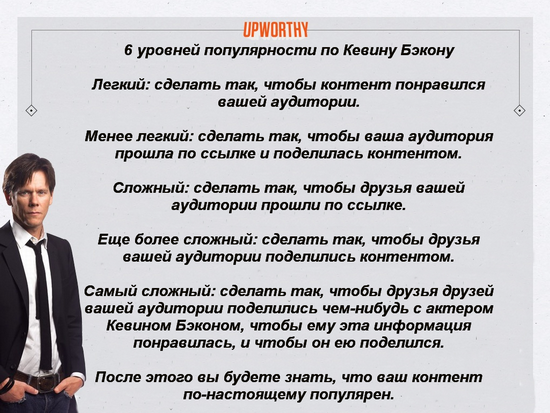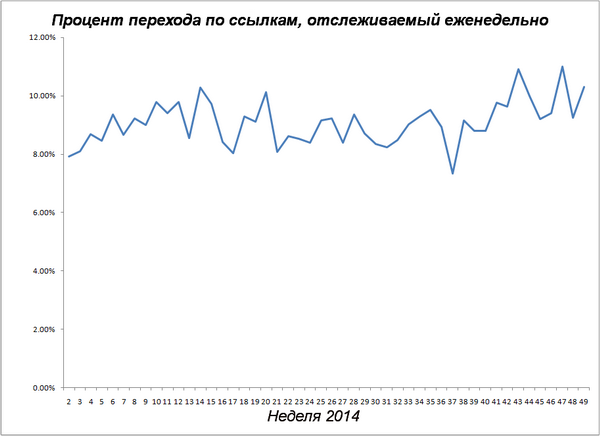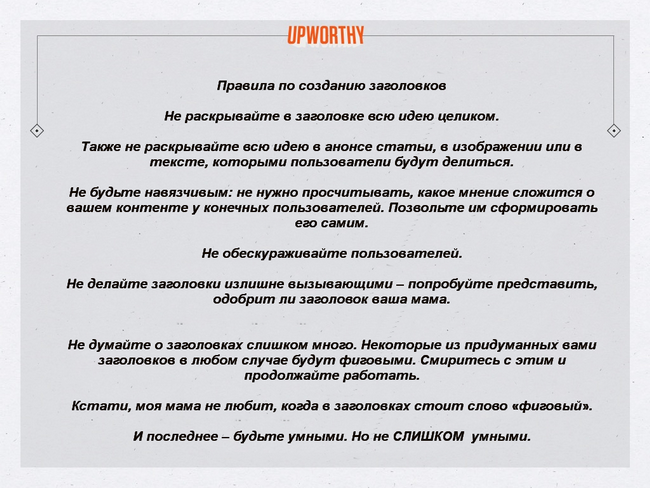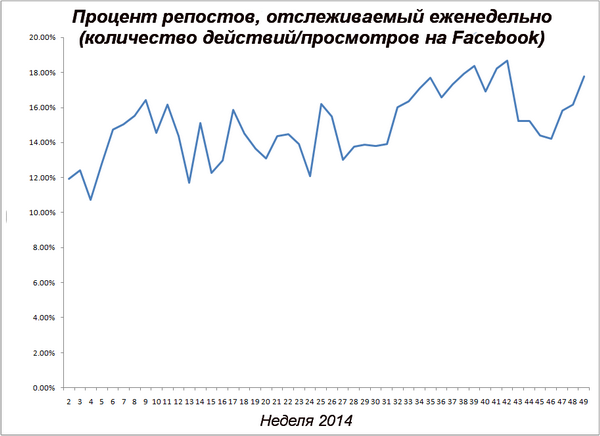As a real estate blog, in 2 years it was possible to increase the number of monthly visits to the site from 2 thousand to 18 million. (Part 2)

In the first part of the article, we already talked about where the guys from Movoto started, and what development strategy they chose. Now your attention - the continuation of the experiment. With detailed comments and graphic content.
Rely on data, not what seems popular

')
Thus, it is very important to understand that even if you think that your content will delight users, this does not at all mean that it will actually delight them.
Here we kind of come back again to how the process of generating and refining ideas was described. We sincerely believe that any thought needs to be supported by evidence, and this rule also applies to the process of creating successful content.
Sites such as BuzzFeed place information on the number of page views in large shimmering letters at the very top. But the number does not matter; you need to know exactly how these views were obtained:
• Inside the site's audience.
• Through social sites.
Unlike BuzzFeed, Movoto could not rely on internal traffic, so they had to make their content popular on various social sites.
To do this, you can use the tools that allow you to look deep into and determine the true popularity of the content.
On the BuzzFeed website you will find any information that is required for writing articles. If you register on the site, then get access to the information base of articles. Here are the articles that were able to increase their audience by 10 or more times. If an article was less popular, then BuzzFeed’s internal tools helped it increase the number of views.
On other sites we can refer to such tools as BuzzSumo and Ahrefs, which allow to study in detail the potential of any content in terms of its popularity and the number of clicks on the links.
Using this approach, you have determined the type of content that promises to be popular, and calculated that it is able to increase its own audience by 8 times, and for this you do not need to run, like a squirrel in a wheel. Now you can try to realize your idea. This will allow you not to waste time and energy on "just good ideas" and engage in testing really good ideas.
Of course, you may have your own original ideas, but we offer you a proven strategy for creating successful content. Following this strategy, in Movoto they take risks from time to time, but this allows them to avoid the appearance of a sad oblique straight line on a site’s popularity chart, which can only make a fan of riding a mountain bike happy.
Identify and learn from leaders.
Here are the names of two sites that in the past 2 years helped Movoto to answer most of their questions, and which you may have heard before: BuzzFeed and Upworthy.
The explanation is simple: they create content that inspires any other content-oriented website to share unique information that can become truly popular (and which other websites will link to).
These two giants of the content world are considered as such because their owners have already understood how to create competent content. They really learned it. In Movoto (for now!) They are not trying to compete with them, but they realized that they can learn a lot from them.
Fortunately, the owners of these sites do not make a big secret from their strategy (as, by the way, one well-known site about real estate).
Popularity is the highest degree of brand awareness.
The methods that have been described up to this point, were aimed solely at increasing the number of clicks and the number of references to Movoto content in other sources. But in order to advance further, it was necessary to understand how to win real popularity. The guys completely accidentally found the answer to this question in October 2013.

To increase the number of clicks on the link, you must very well submit information.
If we talk about how to make content popular, few people get it better than Upworthy (if there are any). The owners of this site also actively share information about how they achieved popularity or what efforts they are making to achieve it - they often remind users that Upworthy cannot guarantee popularity.
However, according to Upworthy, there are many measures you can take to make your content popular.
Popularity, in fact, is reduced to an equation with two variables: the percentage of clicks on a link and the percentage of reposts. It may seem that everything is too simple, or that these indicators do not have a particular impact on the content. In fact - have.
Link Hop Ratio

You can regard the optimization of the click-through rate as the best method in terms of the impression it makes on Facebook users. Or it may seem to you that this optimization is simply deceiving users.
In any case, this method is to attract users to get acquainted with your content. In the end, if no one sees your content, then no one can share it, and you'll have to forget about popularity.
If we talk about Facebook, then the optimization of the percentage of clicking on links is based on the improvement:
• Header.
• Images.
• A brief description of the page (subtitle / text of the advertising message / etc.).
These parameters need to be changed so that as many users as possible enter your page, and so that as many of them as possible share your content.
Creating the perfect headline

When they say “perfect headline” in Movoto, they mean the following:
1) the optimal style of the title depends on the type of content that you create;
2) the “ideal” type of heading is not open yet, which will provide a 100% link click.
It turned out that for content in the format of ratings or lists, headers that contain numbers work best. These are BuzzFeed style headlines. For example:
• 33 things that Michigan residents must explain to visitors.
• 41 facts you probably didn't know about Irvine.
• 30 facts you need to know about Kansas before moving here.
You might have thought: “But these headers contain too much information and / or numbers!” You are right. For this type of headers, numbers work just fine. And the reason that fairly large numbers are used in these headlines lies in the concept that large numbers included in articles with ratings and lists are more likely to attract the attention of users. In fact, content that offers readers more information is usually considered more reliable.
But let's go back to the types of headers. For video files, curiosity and Upworthy headlines are most appropriate. Here are some of the best examples:
• This famous artist wants everyone to know how to pronounce the name of the city of Boise, and it works great for her!
• These women did not even know that they were waiting for them in a shopping center in Austin. You will be shocked when you see what eventually happened.
• It took the guy 2 years to create a project. If you are from Chicago, then you should know how it all ended.
As you have probably already guessed, it is much more difficult to make such a heading correctly than the heading for an article with a rating or a list.
Returning to Upworthy: Movoto spent several months trying to figure out exactly what causes curiosity among users and how to successfully apply this method of creating titles for video content. To bring this strategy to perfection (or at least come close to it) was for Movoto a key task in the process of increasing the average link percentage from the initial 3% to 9% or more.
The concept of awakening curiosity includes not only the basic structure of the title, but also carefully selected words and phrases. There is also the concept of an “invisible person” - this is a person present on the video, which if necessary can be mentioned in the title describing his type of activity: “famous musician”, “high school student”, “astronaut” - anyone. Experience shows that the use of such a technique almost always leads to a significant increase in the percentage of clicking on links.
Competent image replaces a thousand words - and is able to provide several thousand clicks
An integral part of the process of optimizing the percentage of clicking on links is the selection of an image. How important is it? In Movoto, they spent almost a year trying to figure out what the image should be like that could provide as many clicks on Facebook as possible. After all the trial and error, the guys found out that people like the images:
• Other people (especially people in the process of eating food).
• Sculptures depicting people.
• Women in bikinis (note: in Movoto, they focus their ads on Facebook exclusively on the female half of users).
• Wizards (do not ask why).
• Handwritten inscriptions and drawings on all the above types of images.
If you want to quickly increase the number of clicks, then use the image of people. It's simple.
As for the latter type - images with handwritten inscriptions - in terms of the number of clicks, such images almost always triumph.
In addition, although it may seem a trifle, try to follow the rule of thirds when choosing an image, and it will also give a tangible positive effect.
Subtitles: leaders optimize the percentage of the transition links for the version of The Unsung

Competently subtitles are able to give users who view your ads on Facebook the very final incentive to feel the desire to get acquainted with the material.
As in the case of other aspects related to the percentage of repost (it will be discussed below), it turned out that the shorter and smarter the subtitle, the better. However, there is such a thing as too clever subtitles.
Repost percentage: Facebook is your best friend

As in the case with headers, two basic methods were used to optimize the number of reposts in Movoto. The choice of a method depends on the type of content you plan to create.
Movoto began with original content - articles with ratings and so on. (by the way, they still focus on this content). For this type of material, two incredibly effective rules have been identified that you should always follow if you want as many users as possible to share your content. These rules are very simple:
1. Tell a story.
2. Focus on user identity.
The first rule speaks for itself. A popular post must have a history in its structure - wherever possible. Even if we are talking about "Ten stereotypes about the inhabitants of such a city", which can hardly be combined into one story.
Did you catch the thought? It seems people tend to read content that is written about them. For example, readers do not pay special attention to the statement that such and such a restaurant is a good one, unlike the statement that people love such and such a restaurant for such and such reasons.
Therefore, you should try to create content for people wherever possible. For most authors, this is a very rigid framework, but the increase in the number of reposts (and, as a result, the growth of content popularity) is worth doing this work.
The second method listed above concerns the placement of video files. The number of reposts reaches its maximum when video files are given the opportunity to do most of the work themselves.
The most effective were such approaches to optimizing the percentage of reposts for such publications:
1. The minimum duration (less than 50 words, of which only a few words sometimes depend on the context).
2. Presence of opinion.
3. The video should be about people (this rule also works here).
This conclusion was reached in Movoto after they found the best creators of this type of content and studied the methods that helped them the most. Result: the number of reposts on average increased by 20% or more. And this is not the limit!
Combine it all together, paying attention to the details!
But we left the most boring part in the end: this is SEO optimization.
SEO optimization is a great tool, because it is the only aspect in the entire content marketing field that is completely independent from outsiders. Only you are responsible for it, which means that you can always do everything right.
SEO optimization boils down to two important concepts:
• Text on page.
• Site structure.
Text on page
This concept includes a lot:
• Research key queries.
• URLs.
• Article title.
• H1 headers.
• Headers H2.
• Image tags.
• Is the site convenient for users of mobile devices?
Movoto tries to make the basis of each article a key request. Some keywords are obvious, and with some you need to steal a little. For example, in some articles, the keywords are in the URL, but writing the headings for robots will not help you increase the popularity of the content.
So go to the URLs. This is the easiest way of SEO optimization, and in Movoto they have always been used, since the clarity of the key query allows you to raise an article in the list of search results. But now it's worth talking about testing a new URL format, with an emphasis on social optimization.
As you learned from the section on popularity, in Movoto, first of all, demonstrate the title of the article to the reader. And try to include a keyword in the title, better - in its beginning.
It is very important to have subtitles of the first level (H1). It is more correct that the subtitle H1 echoes the title of the article - this will allow readers to make sure that they are moving in the direction they wanted. For what? There is a theory of “optimization of the page of hit”, according to which the main title on the page should coincide with the name of the link that you followed to this page. This approach allows you to make sure that the title coincides with the link, and everyone gets exactly on the page that he wanted.
H2 subheadings serve two purposes. First, they break the whole article into readable chunks. In addition, H2 subheadings can enhance the effect of the keywords used in this article. For example, if the article talks about where it is best to live, then the names of such places should be contained in the subheadings H2.
Image tags don't tell users anything. This is an easy way to emphasize what is written in the article. Every day, about 300 images are added to the site in Movoto, therefore, alt-tags are standardized under the page name. Ideally, such tags should describe the image.
Finally, having a mobile version allows you to make sure that those who read your site can really use it. In the case of Movoto, more than 75% of subscribers access the site from their mobile apps or tablets.
Site structure
The structure of the site allows you to enhance the positive effect from the use of any other means of content marketing. In particular, it allows users to pay attention to the most important pages of the site. The easiest ways to achieve this:
1. Make sure your content is in a subfolder, not in a second-level domain.
2. In the body of each article, insert links to the most important pages of the site.
3. Create clear and understandable category pages that will serve as a repository of the best content on your site.
# 1 - If you decide to create a blog, then use the link www.movoto.com/blog instead of the link blog.movoto.com. a significant increase in the popularity of the domain center is the main reason for starting content marketing. Do not lose the results of these works, placing all the content on the domains of another level.
# 2 - Redistribution of the popularity that your site earns, to its other pages, is carried out by means of links. All articles on the site Movoto somehow related to real estate. This allows them to place links to cities and key pages of the site, even if the essence of the article is completely different. Links also allow users to find out the best about your site if they are interested in using it.
# 3 - You need to make sure that all the content of your site can be found through Google, and also focus users on important publications. This goal can be achieved by placing the most important categories at the top of the site. Then on each page of the site there will be a link to this category, and this will allow Google search engine to know that this category is important.
Results - Popularity, Traffic, and Subscriptions
Content marketing is a tough competition, and in order to succeed, you have to work hard. After almost 3 years, Movoto achieved the following results:
• 3,198 published articles.
• More than 120 million visits.
• More than 18 million actions on Facebook (likes + reposts + comments).
• 41,000 email promotions (55%).
• More than 30,000 links to site content.
Thus, each article on average receives:
• 37 500 .
• 5 600 Facebook.
• ~13 -.
• ~10 .
But it was not always so. , , .
– , , . , .
, – .

Movoto
, , , . , 2 , . , , .
, – , . – .
Source: https://habr.com/ru/post/283968/
All Articles